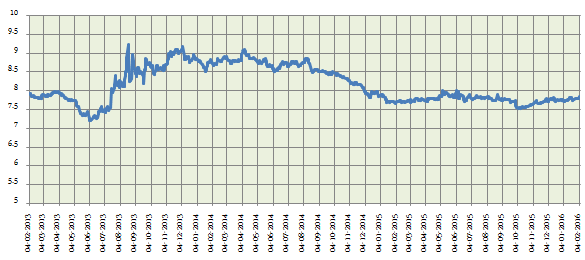What should debt mutual fund investors do in 2016

Gilt fund investors are sure to be disappointed with returns in the last 3 to 6 months. While 2014 was a fantastic year for investors in long term gilt funds with returns average category returns of more than 15%, 2015 was lot more volatile despite a series of rate cuts by the RBI. In fact, if you timed your exit from Gilt funds just after the last rate cut in September you would have made very good returns, but from October onwards 10 year G-Sec yields have been creeping up as the economic environment has become more challenging. The chart below shows 10 year G-Sec yield for the past 3 years.

As per SEBI, debt fund managers have been reducing their exposure to Gilts from October 2015 onwards. Long term Gilt Funds as a category gave average returns of around 6% in 2015. Performance of long term income funds was also tepid in 2015, but slightly better than Gilt Funds. While average income fund returns were down year on year from around 14% in 2014, these funds on an average gave 7% returns in 2015. On the other hand, short term debt funds put on a much better show than their long term counterparts. Average returns of short term debt funds was 8.3% in 2015, while top performing funds in the category gave nearly double digit returns. 2015 is done and dusted with. The quick recap of debt fund performance in 2015 is a prelude to the topic of our post today. With 2015 done and dusted, let us now focus on the outlook for 2016. While 2015 overall was a challenging year, the global macro-economic scenario today is more challenging than what it was 6 months back. We shared some perspectives on 2016 in our blog post, What can we expect the equity market to do in 2016. While the article referenced was from the perspective of equity investors, macro-economic challenges impact both equity and debt investors. In this post, we will summarize the challenges and opportunities for Indian debt fund investors in 2016.
Global macro-economic outlook
The global macro-economic outlook remains challenging in 2016 and it will have a direct impact on debt investment returns. The three major concerns to look out for are:-
- The economic problems of China have been dominating the headlines for the past few months and are well known to most investors. For debt fund investors in particular, movements of the Chinese currency will be a major risk factor. Further devaluation of the Chinese Yuan (CNY) will put pressure on other emerging market currencies including India. The Indian rupee (INR) depreciated 4.7% versus the US Dollar (USD) in 2015. At the same time, it has out-performed on relative basis against the basket of 12 currencies in the Asian currency basket. Dhawal Dalal, Executive Vice President & Head - Fixed Income at DSP BlackRock, in his interview to Advisorkhoj, expects the INR to maintain a depreciating bias in 2016 as well amid overall weakening bias in the EM currencies against the dollar and trajectory of the CNY going forward. A depreciating rupee will cause G-Sec prices to fall and bond yields to rise, making it challenging for long duration fixed bond investors.
- While low commodity prices, particularly crude oil, has been a major challenge for equity markets globally, it has been extremely beneficial as far as inflation in India is concerned. While lower inflation is good for the Indian economy, it is particularly helpful for debt investors, because low inflation provides stimulus for Reserve Bank of India to reduce repo rate, which in turn causes bond prices to increase. However, the effect of low commodity prices is a little more complex in the current scenario. Low commodity price is causing risk aversion in markets globally, leading to FII outflow from equities, especially in emerging markets like India. FII outflows will cause the Indian Rupee (INR) to depreciate further.
- What the United States Federal Reserve does this year will, in our opinion, have the biggest impact on fixed income or debt returns in 2016. The US Fed hiked the Fed funds rate by 25 bps this December. Economists and market analysts are split on the effect of the Fed rate hike and the impact of the actions going forward on the global economy. One school of thought is that, the increase in US policy rates indicates a stronger US economy which should ideally be positive for global exporters and for global growth. History suggests that consistent quarterly increase in US interest rates is positive for EMs and India. The other school of thought is that, the hike came too soon and the favourable employment data in the US notwithstanding, there is no adequate evidence that the US economy is firmly on the growth path. The economists and analysts are split even on the interpretation of the minutes of the recent Fed meeting. While some analysts are characterizing the tone of the minutes as hawkish, others are characterizing this as dovish. If you are confused after reading this paragraph, do not worry, even the market is confused. However, one point is quite clear, as far as debt investors are concerned. If the Fed hikes US Fed funds rate further this year, it will constrain the ability of the Reserve Bank of India to cut rates, because of the impact of strengthening dollar versus the rupee. The RBI monetary policy announcement had hinted to this effect. This is not to say that, RBI will not cut rates this year, but the quantum of rate cuts will be lower than what we were expecting 3 – 4 months back, if the US Fed hikes interest rates this year.
Domestic macro-economic outlook
The domestic macro-economic outlook is less challenging than the global scenario because the macro fundamentals of our economy are improving. However, debt fund investors should not ignore near term risks.
- The RBI monetary policy announcement earlier this week was very much on expected lines. It is clear now that, for debt fund investors the next major event is the Budget. Debt fund investors should understand that fiscal deficit has a direct impact on the bond yields and bond prices. Dhawal Dalal of DSP BlackRock, expects the “long-end of the yield curve (20Y+) to relatively under-perform 5-10Y segment of the yield curve in 2016 amid expectations of upward revision in the fiscal deficit in FY17 and demand-supply dynamic”. The effect of 7th central pay commission increase may potentially have an effect on fiscal deficit. While the Government has maintained that, 7th pay central commission and one rank one pension for ex-servicemen will not have an impact on the fiscal deficit, we have to wait till the Budget to understand its impact on FY 2017 fiscal deficit.
- For longer term debt investors, the structural reforms which will catalyze growth and at the same time maintain fiscal prudence will be key enablers of a regime of lower interest rates, which in turn will deliver strong return on investment in the long term. The track record of the government over the past one year, as far as reforms are concerned, has not been all that great. The RBI statement says, “Structural reforms in the forthcoming Union Budget that boost growth while controlling spending will create more space for monetary policy to support growth, while also ensuring that inflation remains on the projected path of 5% by the end of 2016-17”. The RBI governor has maintained his accommodative stance, but has put the onus of the Finance Minister to create conditions to enable further easing of monetary policy.
- Inflation continues to be the most important variable monitored by the RBI. While crude and certain other commodities have had a benign effect on inflation, the food price inflation is still a concern. As per early meteorological forecasts, we are expecting normal monsoon after 2 consecutive years of deficit rainfall. This will have a favourable impact on inflation, but it is a risk factor nevertheless, should we see deficit in rainfall again. On the other hand, bountiful monsoon will have a benign effect on inflation.
- Finally, the revival of corporate sector earnings and private sector capex revival is crucial for the Indian economy and the bond market. One of the pain points, as far as our economy is concerned is that, corporate profits have not yet picked up. In fact, corporate profit as a percentage of GDP is at its lowest level in the past one decade. The aggregate Q3 corporate profit growth on a year on year basis was weak, as per CRISIL. Though some market analysts see green shoots of recovery in corporate profits, it is difficult to have a timeline on when we have a confirmation of the recovery. Though government spending has shifted from revenue expenditure to capital expenditure, the revival of corporate profits will result in higher tax revenues, lower fiscal deficit and lower bond yields in the future.
What should debt investors do?
Based on the various factors discussed above, the outlook on the debt market in 2016 is hazy. Many economists and market analysts think that, it is difficult to expect more than 25 bps to 50 bps repo rate cut by the RBI in 2016. As such, the longer end of the yield curve may underperform the lower maturity segments. However, debt mutual funds, offer investors a range of options across the spectrum of interest rate scenarios and various segments of the yield curve (please see our article, Demystifying debt mutual funds). Let your investment horizon determine, where you want to invest. We should recap two important debt fund concepts that we have discussed earlier in our blog.
Yield to Maturity:
Yield to maturity (YTM) is the return which a bond investor will get by holding the bond to maturity. For a debt fund, it is the return which the fund will get by holding the securities in its portfolio to maturity. For example if a debt fund’s portfolio has a YTM of 10% and a duration of 2 years, it means that, assuming no change to the portfolio, the fund will give 10% returns, as long it holds the securities in its portfolio till they mature. i.e. for 2 years.Modified Duration:
Conceptually, duration is the measurement of how long, in years, it takes for the price of a bond to be repaid by its internal cash flows of the bond. Modified duration, as a concept is similar to duration, but by definition is the price sensitivity of a bond to changes in yields or interest rates, in other words modified duration is the change in the price bond with a change of 1% in interest rate. So if the modified duration of a bond is 10 years and interest rates go down by 1%, then the bond price will increase by 10%.
You can find information on yield to maturity and modified duration of debt funds in the factsheets and on various research websites. Debt fund investors should educate themselves on these two important concepts. If you apply these two concepts, along with the outlook on bond yields you will be able to find the right debt fund product for your needs.
If you are a conservative investor with a short term investment horizon, say 1 to 2 years, you should opt for short term debt funds. These funds, as discussed in our article, Demystifying debt mutual funds, employ accrual strategy. The interest rate risk is very low in such funds because the bonds are held till maturity. Look for a fund with sufficiently high YTM, good credit quality and low expense ratio (see our article, Top 5 short term debt mutual funds in 2015).
If you are a moderate risk debt investor and want income over a 3 year or more investment horizon, focus on modified duration of debt funds and the outlook on the yield curve. If bond yields harden the long duration bonds and debt funds will suffer more than moderate duration bonds. As discussed above, debt market experts expect the 5 to 10 years segment of the yield curve to outperform the longer end (20+ years) of the yield curve. If you do not have the appetite for high volatility, income funds with average maturities of 5 to 10 years may be more suitable (see our article, Top 6 long term income funds in 2015). You should consult with your financial advisors if these funds are suitable for you.
Given the hazy outlook on bond yields this year, Gilt Funds investors may be in for a rough ride. It is best to wait till the budget, to get a clear view on the fiscal deficit situation if you want to invest in Gilt Funds. If you are already invested in Gilt Funds and have a sufficiently long investment horizon which encompasses the interest rate cycle, you can remain invested in these funds but be prepared for some volatility in NAVs.
Conclusion
In this blog post, we discussed the outlook for debt mutual funds in 2016. The outlook is hazy as discussed earlier, but we discussed the factors that will determine the trajectory of short term and long term debt funds. Investors who want assured returns can invest in the government small savings schemes. But investors should be mindful of the fact that, the interest rates of government small savings schemes like PPF, NSC, Post Office Deposit etc are likely to go down from April 1, 2016. Also, once the Government reduces interest rates in small savings scheme, the banks are likely to reduce their fixed deposit rates. Debt mutual fund investments are more tax efficient than many small savings schemes and bank fixed deposits over a three years investment horizon. Investors should consult with their financial advisors, which debt fund(s) will be suitable for their investment needs.
Queries
-
What is the benefit of mutual fund STP
Aug 29, 2019
-
How much to invest to meet target amount of Rs 2 Crores
Aug 26, 2019
-
Can I achieve my financial goals with my current mutual fund investments
Aug 24, 2019
-
Can you tell me return of various indices
Aug 19, 2019
-
What would be the post tax return on different investments
Aug 18, 2019
-
Which Principal Mutual Fund scheme will be suitable for my retirement corpus
Aug 16, 2019
-
What is the minimum holding period for availing NCD interest
Aug 4, 2019
Top Performing Mutual Funds
Recommended Reading
Fund News
-
Sundaram Mutual Fund launches Sundaram Income Plus Arbitrage Active FoF
Jan 5, 2026 by Advisorkhoj Team
-
Kotak Mahindra Mutual Fund launches Kotak Dividend Yield Fund
Jan 5, 2026 by Advisorkhoj Team
-
Motilal Oswal Mutual Fund launches Motilal Oswal Diversified Equity Flexicap Passive Fund of Funds
Jan 2, 2026 by Advisorkhoj Team
-
Mr. Navneet Munot's 'Person of the Year 2025'
Dec 31, 2025 by HDFC Mutual Fund
-
Zerodha Mutual Fund launches Zerodha Nifty Short Duration G Sec Index Fund
Dec 26, 2025 by Advisorkhoj Team














